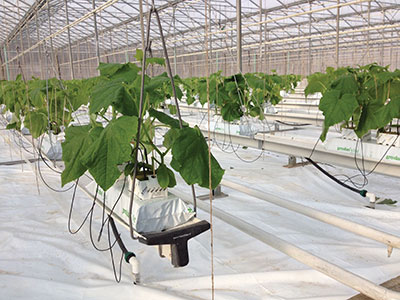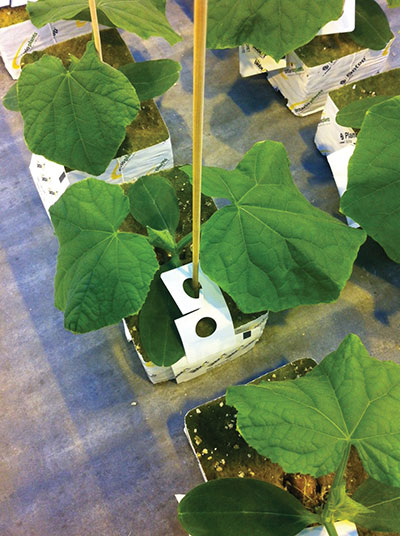
Almost 20 years ago, the possibilities of using BCAs in vegetable transplants were investigated in a project in Europe.
 |
|
| BCAs are quite effective in young vegetable crops.
|
This project took place from 1994 to 1997, and 10 large propagators in the Netherlands were involved as well as the Dutch Plant Health Department, growers organizations, a committee of crop protection specialists and crop consultants. The crops involved were followed closely from seeding until 10 weeks after planting out at the growers’ greenhouses.
This project was initiated because many greenhouse growers were having difficulty getting BCAs established when the plants arrived. Growers would expect a “clean” plant, and in order to achieve this, propagators would use pesticides.
In those days there were few to none “BCA compatible” and short residual pesticides available. There was every reason to expect that BCAs would have trouble with residues from products such as Oxamyl (Vydate) and Methomyl (Lannate). Pesticide residues are something that many counterpart ornamental growers are struggling with more recently.
The project showed that the option of using BCAs as a first line of defence in propagation was a suitable (and successful) option. The number of pests on plants arriving at greenhouses was not significantly different from the number seen on plants that received traditional pesticide sprays.
In addition, the start of the biocontrol systems at the growers’ greenhouses was, in general, much more successful.
At the end of the project in 1997, many growers and propagators were using biocontrol and IPM on young plants at the propagation level, including some Canadian propagators.
During the following years, however, more and more propagators and growers discontinued using BCAs at the propagation level.
Why?
During the mid-1990s, several newer generation pesticides were introduced that were very effective, relatively cheap and easy to apply. However, they also had much shorter residuals on BCAs.
For example, Oxamyl (Vydate) has a residual of at least eight weeks on Amblyseius cucumeris, but abamactine (Avid) only two weeks. More of these shorter residual products were added such as Spinosad (Success) and imidacloprid (Intercept).
The pest management programs of propagators worked well and growers could start their BCA program very successfully … until things started to change.
In late 2006, the first signs of resistant thrips started to show up in the ornamental industry. This also started to affect vegetable growers, especially cucumber growers at first as they typically grow several crops per year.
In 2009 and 2010, growers struggled as plants arrived with higher levels of thrips from propagation. In addition, the residual effects of pesticides on these young plants were giving BCAs a delayed start, and therefore a head start for thrips, and causing damage to plants and fruit.
RENEWED INTEREST OF USING BCAs IN PROPAGATION
■ In 2011, a few cucumber growers and their propagator started to look at other options.
Biocontrol was discussed in detail and decisions were made to start controlling thrips at the propagation level with BCAs. The information from the project in the mid-1990s is still very valuable information, even though a few things have changed.
Back then, Amblyseius cucumeris were tested, and it became very clear that broadcasting on young plants did not give the results that were needed. It was determined that too many mites would not get to their destination (on the plant), but ended up on the concrete ebb-and-flood floors.
Breeder piles of Amblyseius cucumeris were placed on each rockwool block to ensure that each plant would be protected from the start. The available Amblyseius cucumeris breeding sachets were too expensive to be placed on each plant, and since none of the Amblyseius spp mites can fly, distribution is extremely critical when plants do not touch.
The disadvantage of the breeder piles was that they would get lost in the transition of the plants from propagators to growers.
A development in the ornamental industry did shine some new light on this.
MINI SACHET DELIVERY SYSTEM BEGAN WITH ORNAMENTALS
■ About four years ago, a “mini sachet” of Amblyseius cucumeris was developed for ornamental growers. This has been a significant improvement for ornamental growers as they now could distribute a “breeding system” on every hanging basket cost effectively.
 |
|
| Sachets with cucumber plants.
|
In April 2011, these mini sachets were introduced on cucumber plants at a vegetable propagator in Ontario. Every plant received a sachet at Day 8 after seeding.
At the point of delivery of these plants, every leaf on each plant had multiple Amblyseius cucumeris mites running around. The advantage of the mini sachet compared to the breeder pile is that the sachet will continue its remaining lifespan at the grower’s greenhouse, therefore delaying the first introduction of Amblyseius cucumeris or swirskii.
Since then, the first grower who received these plants in April 2011 has successfully completed their seventh round of propagation using BCAs. Other growers have followed their example.
A difference between the mid-1990s and today is the availability of Amblyseius swirskii. It was trialled in cucumber propagation, both as broadcast as well as sachets.
The broadcasting did not show any promising results, just like Amblyseius cucumeris did during the project.
Sachets of Amblyseius swirskii were used, but in order to keep the cost per plant reasonable, one sachet for every five plants was used. This resulted in one out of five plants being protected during a larger amount of days during propagation when plants were not touching. It showed that the (cost-effective) distribution of mites is more critical than the choice between Amblyseius cucumeris and Amblyseius swirskii.
The initial introduction by the propagator is followed up by another introduction of Amblyseius spp (swirskii, especially if whitefly is present) approximately four weeks after planting, once the crop has reached the support wire and contact between plants has been established.
THRIPS PRESSURES ON EARLY SEASON PEPPER CROPS
■ Pepper growers also experience an increase of thrips problems earlier in the season. It is very likely that these problems also originate earlier on in the crop cycle. Starting with a resistant thrips population from propagation and/or a resident population in the greenhouse and residues of pesticides does not help.
An option for pepper growers is to follow their cucumber counterparts, and start BCAs at the level of propagation. Let the population of BCAs establish and grow with the growth of the young plants during propagation. A logical choice! ■
 |
|
Ronald Valentin is biological crop protection specialist and technical trainer and coordinator with Biobest Canada Ltd. and Biobest USA Inc. He was a member of the Plant Propagation Project Steering Committee, 1994-1997.
Print this page